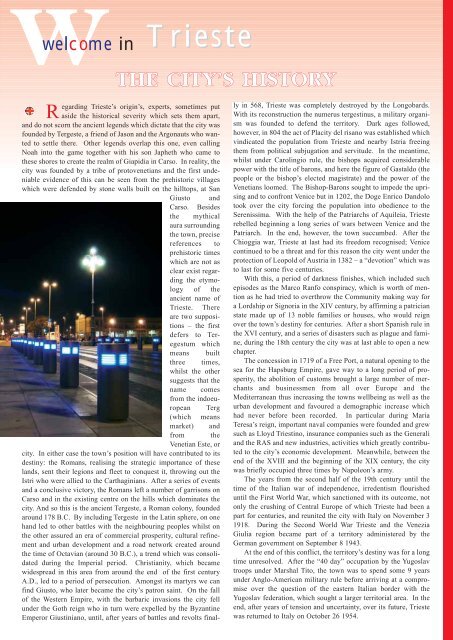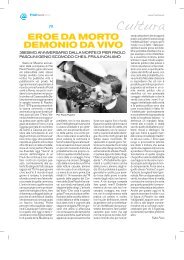You also want an ePaper? Increase the reach of your titles
YUMPU automatically turns print PDFs into web optimized ePapers that Google loves.
Trieste<br />
<strong>welcome</strong> in Trieste<br />
THE CITY’S HISTORY<br />
Regarding Trieste’s origin’s, experts, sometimes put<br />
aside the historical sever<strong>it</strong>y which sets them apart,<br />
and do not scorn the ancient legends which dictate that the c<strong>it</strong>y was<br />
founded by Tergeste, a friend of Jason and the Argonauts who wanted<br />
to settle there. Other legends overlap this one, even calling<br />
Noah into the game together w<strong>it</strong>h his son Japheth who came to<br />
these shores to create the realm of Giapidia in Carso. In real<strong>it</strong>y, the<br />
c<strong>it</strong>y was founded by a tribe of protovenetians and the first undeniable<br />
evidence of this can be seen from the prehistoric villages<br />
which were defended by stone walls built on the hilltops, at San<br />
Giusto and<br />
Carso. Besides<br />
the mythical<br />
aura surrounding<br />
the town, precise<br />
references to<br />
prehistoric times<br />
which are not as<br />
clear exist regarding<br />
the etymology<br />
of the<br />
ancient name of<br />
Trieste. There<br />
are two suppos<strong>it</strong>ions<br />
– the first<br />
defers to Teregestum<br />
which<br />
means built<br />
three times,<br />
whilst the other<br />
suggests that the<br />
name comes<br />
from the indoeuropean<br />
Terg<br />
(which means<br />
market) and<br />
from the<br />
Venetian Este, or<br />
c<strong>it</strong>y. In e<strong>it</strong>her case the town’s pos<strong>it</strong>ion will have contributed to <strong>it</strong>s<br />
destiny: the Romans, realising the strategic importance of these<br />
lands, sent their legions and fleet to conquest <strong>it</strong>, throwing out the<br />
Istri who were allied to the Carthaginians. After a series of events<br />
and a conclusive victory, the Romans left a number of garrisons on<br />
Carso and in the existing centre on the hills which dominates the<br />
c<strong>it</strong>y. And so this is the ancient Tergeste, a Roman colony, founded<br />
around 178 B.C. By including Tergeste in the Latin sphere, on one<br />
hand led to other battles w<strong>it</strong>h the neighbouring peoples whilst on<br />
the other assured an era of commercial prosper<strong>it</strong>y, cultural refinement<br />
and urban development and a road network created around<br />
the time of Octavian (around 30 B.C.), a trend which was consolidated<br />
during the Imperial period. Christian<strong>it</strong>y, which became<br />
widespread in this area from around the end of the first century<br />
A.D., led to a period of persecution. Amongst <strong>it</strong>s martyrs we can<br />
find Giusto, who later became the c<strong>it</strong>y’s patron saint. On the fall<br />
of the Western Empire, w<strong>it</strong>h the barbaric invasions the c<strong>it</strong>y fell<br />
under the Goth reign who in turn were expelled by the Byzantine<br />
Emperor Giustiniano, until, after years of battles and revolts final-<br />
ly in 568, Trieste was completely destroyed by the Longobards.<br />
W<strong>it</strong>h <strong>it</strong>s reconstruction the numerus tergestinus, a mil<strong>it</strong>ary organism<br />
was founded to defend the terr<strong>it</strong>ory. Dark ages followed,<br />
however, in 804 the act of Plac<strong>it</strong>y del risano was established which<br />
vindicated the population from Trieste and nearby Istria freeing<br />
them from pol<strong>it</strong>ical subjugation and serv<strong>it</strong>ude. In the meantime,<br />
whilst under Carolingio rule, the bishops acquired considerable<br />
power w<strong>it</strong>h the t<strong>it</strong>le of barons, and here the figure of Gastaldo (the<br />
people or the bishop’s elected magistrate) and the power of the<br />
Venetians loomed. The Bishop-Barons sought to impede the uprising<br />
and to confront Venice but in 1202, the Doge Enrico Dandolo<br />
took over the c<strong>it</strong>y forcing the population into obedience to the<br />
Serenissima. W<strong>it</strong>h the help of the Patriarchs of Aquileia, Trieste<br />
rebelled beginning a long series of wars between Venice and the<br />
Patriarch. In the end, however, the town succumbed. After the<br />
Chioggia war, Trieste at last had <strong>it</strong>s freedom recognised; Venice<br />
continued to be a threat and for this reason the c<strong>it</strong>y went under the<br />
protection of Leopold of Austria in 1382 – a “devotion” which was<br />
to last for some five centuries.<br />
W<strong>it</strong>h this, a period of darkness finishes, which included such<br />
episodes as the Marco Ranfo conspiracy, which is worth of mention<br />
as he had tried to overthrow the Commun<strong>it</strong>y making way for<br />
a Lordship or Signoria in the XIV century, by affirming a patrician<br />
state made up of 13 noble families or houses, who would reign<br />
over the town’s destiny for centuries. After a short Spanish rule in<br />
the XVI century, and a series of disasters such as plague and famine,<br />
during the 18th century the c<strong>it</strong>y was at last able to open a new<br />
chapter.<br />
The concession in 1719 of a Free Port, a natural opening to the<br />
sea for the Hapsburg Empire, gave way to a long period of prosper<strong>it</strong>y,<br />
the abol<strong>it</strong>ion of customs brought a large number of merchants<br />
and businessmen from all over Europe and the<br />
Med<strong>it</strong>erranean thus increasing the towns wellbeing as well as the<br />
urban development and favoured a demographic increase which<br />
had never before been recorded. In particular during Maria<br />
Teresa’s reign, important naval companies were founded and grew<br />
such as Lloyd Triestino, insurance companies such as the Generali<br />
and the RAS and new industries, activ<strong>it</strong>ies which greatly contributed<br />
to the c<strong>it</strong>y’s economic development. Meanwhile, between the<br />
end of the XVIII and the beginning of the XIX century, the c<strong>it</strong>y<br />
was briefly occupied three times by Napoleon’s army.<br />
The years from the second half of the 19th century until the<br />
time of the Italian war of independence, irredentism flourished<br />
until the First World War, which sanctioned w<strong>it</strong>h <strong>it</strong>s outcome, not<br />
only the crushing of Central Europe of which Trieste had been a<br />
part for centuries, and reun<strong>it</strong>ed the c<strong>it</strong>y w<strong>it</strong>h Italy on November 3<br />
1918. During the Second World War Trieste and the Venezia<br />
Giulia region became part of a terr<strong>it</strong>ory administered by the<br />
German government on September 8 1943.<br />
At the end of this conflict, the terr<strong>it</strong>ory’s destiny was for a long<br />
time unresolved. After the “40 day” occupation by the Yugoslav<br />
troops under Marshal T<strong>it</strong>o, the town was to spend some 9 years<br />
under Anglo-American mil<strong>it</strong>ary rule before arriving at a compromise<br />
over the question of the eastern Italian border w<strong>it</strong>h the<br />
Yugoslav federation, which sought a larger terr<strong>it</strong>orial area. In the<br />
end, after years of tension and uncertainty, over <strong>it</strong>s future, Trieste<br />
was returned to Italy on October 26 1954.













